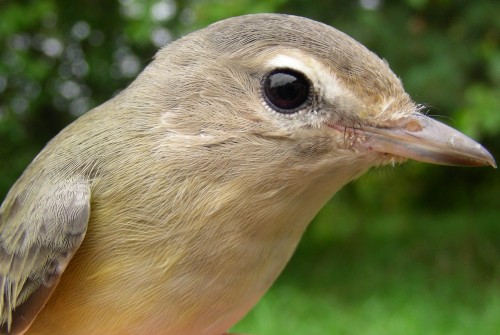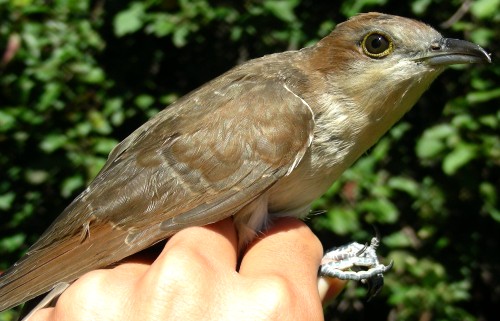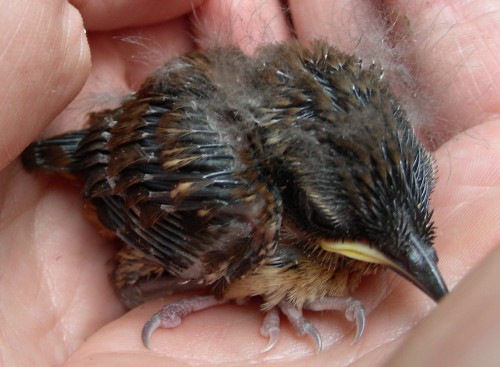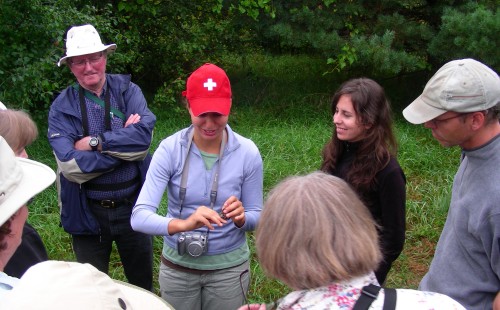|
McGILL BIRD OBSERVATORY |
|||||||||||||||||||||||||||||||||||||||||||||||||||||||||||||||||||||
Welcome
to the McGill Bird Observatory weekly report.
Click here for a complete listing of our archives.
Banders-in-charge: Marie-Anne
Hudson, Barbara Frei, Marcel Gahbauer Notes: This week welcomed Marcel Gahbauer temporarily back to the fold, as he ran the station Wednesday and Thursday and led the second MBO workshop on ageing and sexing of passerines (and near-passerines). We feel the workshop was a great success, and we hope everyone learned a lot and had a great time in the process! The week started off quite slowly, as either the sun shone brightly or it rained – whatever the weather, the birds remained few. However, the birds smiled on us for Sunday’s in-the-field portion of the workshop, and we banded 65 birds of 19 different species, allowing us to show off the birds’ great variation in moult strategy, plumage colour, and general demeanor. We really had tremendous luck with the workshop, as those 65 individuals represented over half of the birds banded this week - as well as the highest single-day total to date this fall! On top of that, the 53 species observed that day also represented the highest daily total of the young fall 2007 season. Despite the rather quiet week we’ve still managed to add species to our list of birds banded and observed, with one especially exciting banding: a young Black-billed Cuckoo graced our nets at closing on Monday morning – the second one of its species ever banded at MBO! Other new species banded include: Black-throated Blue, Blackpoll, Wilson’s, Bay-breasted and Yellow-rumped Warblers, bringing our season total to 47. While that trails a bit behind the 54 banded by this point last fall, we are ahead of the pace with the number of species observed, with 106 as of the end of this week, compared to 101 at this point in 2006. New species observed this week were Double-crested Cormorant (the 100th species of the season), Solitary Sandpiper, Black-throated Green Warbler, Blackpoll Warbler, Northern Pintail, Belted Kingfisher, and of course the cuckoo. Though we haven’t managed to hit 190 species for the site, we hope it will come once migration kicks up into high gear for September and October. We also permitted ourselves a couple of non-MBO banding excursions: we went on one last field trip up to Le Nichoir to band this year’s batch of young crows, as we’ve done for the past two falls. It was a great experience and will hopefully allow them to keep track of the youngsters once they ‘fly the coop’. Thanks to Greg Rand for so expertly grabbing them up and making sure a particularly feisty one nicknamed ‘Satan’ didn’t live up to its namesake! Our other excursion took us to a home in the West Island where a nest of Carolina Wrens was about to fledge. With the permission of the Bird Banding Office, we banded the five youngsters. As far as we know these are the first Carolina Wrens to be banded in Quebec! We’re hoping to see them at feeders around town and perhaps next year if they come back to breed. Fingers crossed! This week’s top 10 species banded is chock full of warblers! The Magnolia Warbler rush that we hinted at last week began in earnest this Sunday, just in time for our workshop. The low pressure system that moved through the area late Saturday night is likely responsible for the very warblery day we had Sunday, enabling the warblers to take over with seven out of the top 12 spots (thanks to a three-way tie for 10th place). Also traveling through the area were lots of Red-eyed Vireos and Least Flycatchers. All these warblers are getting us quite used to banding very small birds, which will serve us well when the waves of kinglets arrive a few weeks from now - though we will have to readjust when the American Robin movement begins in October!
American Crows continue to dominate the top 10 species observed this week, especially since over 200 of them were spotted sitting about the fields adjacent to MBO on Sunday. American Goldfinches and Black-capped Chickadees also again rounded out the top 10. Below the top three, however, changes were made! Cedar Waxwings, Song Sparrows and Common Grackles shuffled around slightly, but more interestingly, House Wrens, Red-eyed Vireos and American Redstarts made the list. For a warbler to make the top 10 observed species indicates just how many are in the area! We’ve been sure to take plenty of photos for our photo library, as American Redstarts can show quite a bit of variation when it comes to their plumage – both due to age and sex. The workshop participants now know that all too well, as many came through on Sunday and allowed themselves to be showcased to the group by workshop leader Marcel. Though they didn’t make the top 10, we were also excited about the reappearance of a few Bobolinks in the fields next to MBO. We’d been hearing their metallic little calls for the past few days but never spotted them until Sunday’s session – much to our relief as we were starting to doubt our hearing and/or sanity!
|




